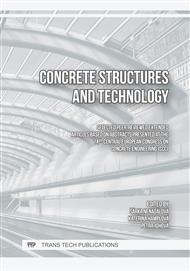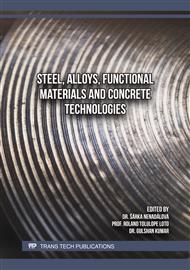p.53
p.59
p.67
p.77
p.85
p.95
p.101
p.109
p.117
An Innovative Approach to Evaluating the Freeze-Thaw Resistance of Concrete Using the Ultrasonic Pulse Velocity Test
Abstract:
This paper deals with the experimental determination of the freezing and thawing resistance of concrete using an innovative approach to evaluating the signal obtained by the ultrasonic pulse velocity test. Test specimens made of two types of concrete were used for the experiment. They were concrete mixtures of similar composition - the same components were used for their production. The only major difference was their level of resistance to freezing and thawing. The test specimens were prisms produced in the laboratory using plastic moulds and cylinders obtained by core drilling from the experimental pillar. The core-drilled test specimens were exposed to 100 freeze-thaw cycles and the test prisms with as many as 200 freeze-thaw cycles. After every 25th cycle, the non-destructive parameters were determined using the ultrasonic pulse velocity test as well as the resonance method. It was found that more advanced parameters of the ultrasonic signal than just its velocity were useful for evaluating the freezing and thawing resistance of concrete.
Info:
Periodical:
Pages:
95-100
Citation:
Online since:
May 2025
Authors:
Price:
Сopyright:
© 2025 Trans Tech Publications Ltd. All Rights Reserved
Share:
Citation:



